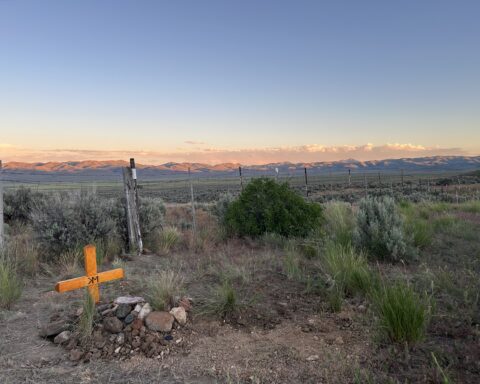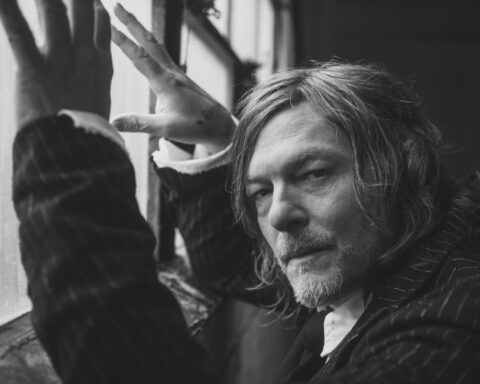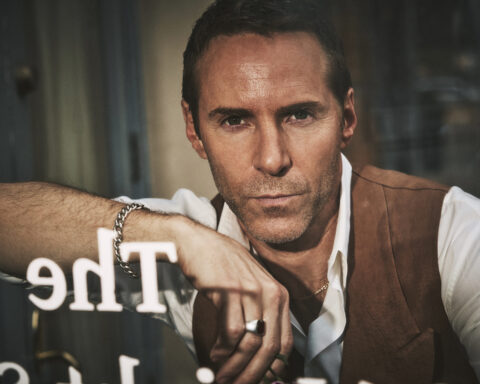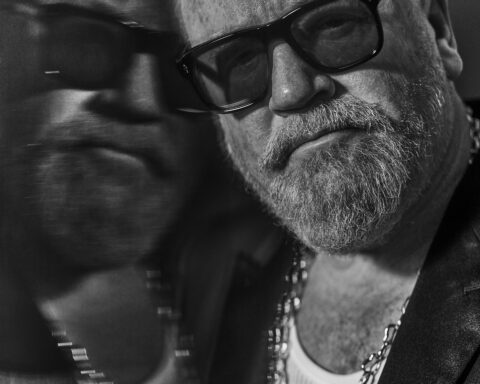You would be forgiven for walking past this patch of urban land in Eagle Rock, Los Angeles, without so much as a second glance. If anything, you might think it looks a tad unkempt. But if you take the time to pause and look a little closer, a world of vibrant, biodiverse, indigenous plants, insects, and birds comes to life before your eyes.
The man behind this horticultural hotbed of growth and rejuvenation is David Newsom. Having benefited from a lifelong appreciation of nature, David decided midway through life to uproot a substantial acting and producing career to focus on rewilding the earth, beginning with his own backyard.
Having bought his first LA home with his wife, the Oscar-winning writer and director Sian Heder, following the birth of their first child eight years ago, David decided against the typical path of seeding a neat and tidy lawn, instead reading and reaching out to experts in native plants, and voraciously educating himself on the subject. This set David, also a talented fine art photographer, on a path which led to him founding the Wild Yards Project, a collaboration between a team of writers, directors, editors and cinematographers, together with some of the foremost authorities in the native plant movement of Southern California, to inspire people across the country to transform their lawns back into vital native plant and animal habitats.

The World Wildlife Fund recently announced that the natural world is losing 10,000 species a year, due largely to habitat loss. This little patch of land in Eagle Rock, while not appearing postcard-pretty at first, is a beautiful example of David’s work trying to combat this global crisis. And it contains simple ideas and processes we can all employ to contribute to changing this tide in our own small ways.
As someone who has always found great peace and enjoyment in the realms of nature, and who when barely a teen, had a job mowing neighborhood lawns, I must admit to an absolute ignorance when it comes to flora, fauna, flowers and native indigenous planting. So I jumped at the opportunity to speak with this green-fingered activist – whose intention is to spread the word, and offer facts and solutions – about the history of this dire predicament, and what we can do to stop it continuing to accelerate in the future.
I learned that as Europeans colonized the Americas, they brought with them a determination to replicate their original homelands while also driving manufacturing growth, thus uprooting the natural fauna and disrupting centuries-old indigenous ecosystems that were revered by the natives tribes that have lived in harmony with them for centuries. I learned to look beyond the veil and discover the vast amount of life that small land patches such as this one provide for. I learned that leaf blowers are the enemy, in their release of carbons into our air, and also by denying the soil and subsoil of valuable and powerful nutrients.
Sitting and talking by this special patch of land, owned by the local church and kindergarten that David’s two children attended, here are some highlights from our conversation.

When and where did you discover your passion for the outdoors?
I grew up in the New Jersey suburbs in the 60s and 70s. When I was a kid, I was surrounded by farmland. Farmland that had been grown over by secondary and tertiary forest. I grew up scrambling around those woods. We had box turtles, tiger salamanders, pickerel frogs, and wood frogs, and I was obsessed with it all. Even though I was a representative of everything that was undoing that beautiful land — where we lived there had been a post World War II development boom — at least I got to have a really nice time engaging with it. Little did I know, this was something that would soon be gone.

How did you come about transforming this land here in Eagle Rock?
One day we were looking at this big stupid lawn and my wife suggested, ‘That would be a fun one to turn into a meadow.’ My initial response was, ‘That would be so hard!’ There used to be a chapel here until it came down in the 1971 earthquake, so under here there’s all sorts of garbage, brick, glass, wood, everything. So I talked to the pastor, and he was like. ’Sure!’ I didn’t know any better, so basically we scraped the lawn away and dumped it into a big 12 cubic yard dumpster, and then put down 35 cubic yards of mulch and let it sit.
What happens is, when an area sits and has a bunch of non-native plants on it, it creates what’s called a seed bank. A seed bank is just an underground storage of seeds. So, there’s about 25 different invasive weeds in this spot, that had been there for about 70 years, as the seed bank accumulated these non-native invasive plants underneath this dead lawn that they had. So, we dug it out.
All the plants that you’re looking at, they’re all going into dormancy now, and that’s how many plants in Southern California handle the extreme heat. Not all of them, not the evergreens like toyon, oaks, or ceanothus. But sage and things like that will start to look pretty ratty because, basically, plants are built upside down. Their feet are in the air and their head and body are down below, They do everything they can to maintain a healthy root system.
For some people, it is not attractive, because it’s not manicured and beautiful, but this is where life happens. Right in here, in the leaf litter, where the leaves fall down. This relationship between these plants and this leaf litter is a powerful engine for life.

Tell me about the importance of indigenous planting?
In indigenous culture, the first thing they talk about are the plants. And then, they talk about the animals. And then, they talk about themselves. They’re a very small speck at the bottom of this inverse pyramid, where there’s a lot happening to keep you alive. When you look around here, except for those two oak trees, every single tree is from South America, Australia, China, so what you have is 96% of the planted canopy for Los Angeles, and this is true for most cities, is non-native. And therefore, 96% to 100% of that is hostile to the wildlife that was from here. California is one of the most biodiverse states in the union, and of all the greatest biodiverse regions of California, the chaparral that surrounds Los Angeles was the highest. It also now has the highest rates of extinction of anywhere in the United States. So one of the easy fixes is to simply retrofit indigenous plants back into the system. This wasn’t built to be beautiful, a showcase garden, this was built to be a hard-ass resilient native meadow, and to be a place that supports a great diversity of life.

What plants are we looking at on this patch of land, and where do they come from?
I would say 90% of them are propagated from indigenous ecosystems within five miles. So, Griffith Park, LA River, and some in the hills here. They’re all native species from this region. The reason you do that is because plants and animals evolve together. So the further you get away from the plants of that region, the more you alienate the wildlife that’s from there. 90% of all leaf-eating insects are specialized, and birds eat between 6000 and 9000 caterpillars per clutch, and a lot of birds, like chickadees, will have three clutches a year. So the amount of protein that your ecosystem has to provide is vast. We try to do combinations of plants that are hosts, as well as pollinator-friendly plants. There is only one kind of native milkweed, and we have about 30 of them planted. The monarch butterfly’s only host plant is milkweed, but they pollinate everything.

How did you reconnect to working with the land?
The thing that was always clear to me, even though I was always kind of lost and I never really knew where I fit in or what I was supposed to be doing, was that my connection to the land would always anchor me.
I started working with a shaman doing ayahuasca, around ’99. I had an experience back then that was somewhat terrifying and mind blowing. The big question that came out of that experience was from Mamasita Ayahuasca, the spirit of the mother, or whatever the hell you want to call it, and I had no frame of reference for that at the time. It was basically, ’Where have you been? I need you.’ So then, I started to orient my life back towards the land. I was always photographing the land, thinking about the land, and thinking about what I would do next. So I started producing documentary television, met my wife, produced her first short [‘Mother’, 2005] and then we fell in love and had kids. The minute my wife was pregnant with our daughter, I knew that I had to do something to introduce wildlife back into my life. This [their family home] had to be a place where I would introduce my daughter to nature. I grew up with at least a baseline connection to nature and I was terrified that suddenly she, and eventually our son, wouldn’t have that. That it wouldn’t be in their vocabulary, that they wouldn’t have that connection. And if you don’t grow up in an expectation of it, then it’s harder to think of preserving it later.
The main thing that was always really clear to me is that I took a shitload of solace from being outdoors. That was always where I could reconnect, and be okay, and get through the next chunk.

How many of these projects do you have going on, and how are you spreading the word?
I work with a group that have a bunch of projects going on all over the city. This one I take care of. And then I have probably 20 gardens, private gardens, that I’ve designed and installed. Then I speak all over the country. I’m not a botanist, I’m not a scientist. My job is to be a storyteller in this movement. The whole idea of Wild Yards Project was inspiration, education, and then implementation. So if someone then visits my Instagram feed, hears about my site, and says ‘Oh I wish I could do that?’ I’m like, ‘You can, you just don’t know it. Here’s a native plant nursery in Florida, Milwaukee, or Maine, and here’s someone who does the work.’ All I’ve ever tried to do is just be a cheerleader for the indigenous ecosystems and the indigenous habitat movement. And try to help people to connect the dots really fast.

And what do you have planned in the near future?
I speak with different organizations all over California and I’m giving a talk in Massachusetts in a few weeks. In a few months I’m doing a keynote speech at a botanical society in Des Moines, and I just did a keynote speech for an educational facility, a horticultural center up in Portland. Again, because I’m not a California native, I work with California native plants because that’s where I live. But there are really phenomenal indigenous educators, museum botanists and heads of the tent who really know this land and really understand the botany of these plants. There’s many Chumash and Tongva teachers in this area. There’s experts like Katherine Pakradouni and Nicholas Hummingbird, who is probably one of the best cultural, botanical, and horticultural educators of the indigenous landscapes that I know of in this area. I’m just learning as I go, collecting intelligence.

Give us a little backstory on how the land has changed over the years and centuries?
Well, the Spaniards came to Cali in the mid 1500’s, and in the 1800’s they gave a large part of it to Mexico. Throughout all of that time, it was a raw deal for the indigenous tribes that tended these lands, and it only got worse, much worse, when the Europeans arrived, fired up on ‘Manifest Destiny’ [a widely held belief in the 19th century that the United States settlers were destined to expand across Northern America]. The indigenous landscape and people were just exterminated and displaced. So that’s what happened to the land. The idea was to make it in your own image, your own design. And if you read about the history of even the national park system, it always sounds like this great idea of preserving, but really what they wanted to do is create a very nice playground for white people. So that was all about the extermination of any predator that would compete with man for hunting deer. They worked very hard to get rid of wolves, black bear, coyote, mountain lions, all across the United States. That began in the early 1900s, tied in lockstep with the advancement across the country. So the deeper you get into this, the more you learn about how indigenous cultures handled and were stewards of this land. They didn’t just leave it alone, they actually managed it, because it was food for them.

What do you suggest to those interested in picking up the shovel and cutters?
To do it. It’s like anything, you’ve got to do the work. I didn’t start doing any of this until I was 52 or 53. I had no interest in gardening prior. I didn’t know anything about the botany of the land. I’d never known anything about horticulture. It was when I decided I wanted wildlife in my yard, the first thing you need are the right plants. And so that was it. I just began to try and fail, to put things into the ground and to kill them, or put the wrong things in the ground and then try to see who gets along. As I always tell people, the best way to begin is to begin. Have an intention. And because I’d been producing documentary TV for 12 years at that point, I’m fearless about, ‘Oh that person runs the museum. F*** it. I’ll just follow him.’ I’m just a dad who wanted to do this. I’m not a scientist, a botanist. But basically as a restoration site, a site that’s here to support wildlife, it’s fun. And so even all the weeds that are coming back and all the prep that I did incorrectly, all of it is my teacher. Once you put these things into play, you’re stewarding them. You’re trying to guide them, but they’re doing their own thing. So I didn’t know anything. I just started.

For someone like myself, who was ignorant to what you’ve shared, I find myself inspired and enthused by what you’ve shown us today, like you’ve unveiled something quite extraordinary, something that’s living right beneath our feet.
It is veiled. See, here’s the thing. For most of our history as a species, as homo sapiens, it wasn’t veiled. We were intimate with all this. We understood when it would go to seed, when it would flower. If we cut it back a little bit, we knew it’d get three times as much yield. We knew when the nut was healthy and when it was toxic. We lived off the land. Our brains were bigger. It was abundant. And then we’ve spent the last 400 years shutting down our relationship to it all. I want that back, to the extent that I’m able to get it and give it. What I love about it is that it responds, it likes stewardship. It likes to be interacted with.
The part that makes me so sad is that it was like a tabula rasa. Wiping the original slate clean and building something we want. Therefore we lost an intimacy with the land, did a whole lot of damage and in doing so, created a whole lot of trauma for the things in the path without realizing we were also doing it to ourselves. That’s sad to me, it’s unfortunate. There were a hundred and something tribes in California alone. They each had different languages and they had a very deep cultivated relationship with the land. They had seas with an abundance of fish, there was so much food. What I’m learning is that when you give the land a chance, it comes back. It doesn’t need a lot to do it. It just needs to be allowed to do it. So that to me is filled with agencies. And that’s f***ing cool.

Facts to consider:
- In the United States, 55% of our country is taken up by urban and suburban development.
- A further 41% is taken up by farmland, leaving a meagre figure of 4% of wild space. 5% of carbon emissions in our air come from lawn mowers and leaf blowers.
- There are 40 million acres of lawns in the US which determines it as the largest crop space/potential and yet we don’t grow anything here or eat from it.
- Rather we dump 90 million pounds of pesticides on our lawns/gardens every year and each day, the conservative estimate is that we drench them in 9 billion gallons of water.

Learn more about the Wild Yards Project at their website and Instagram








